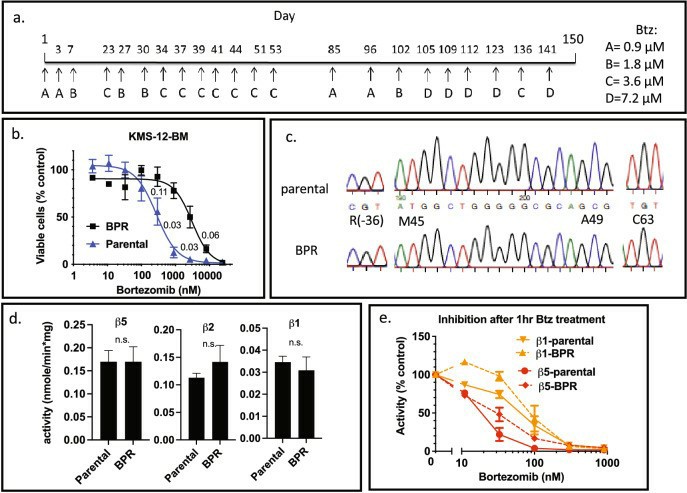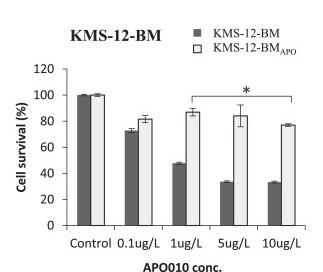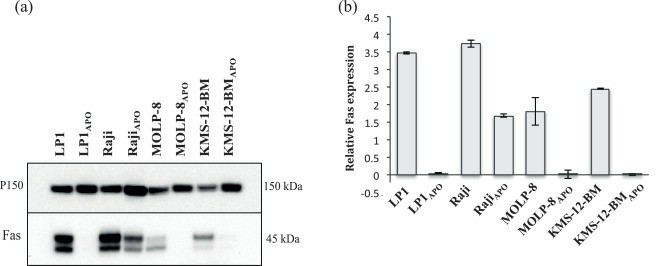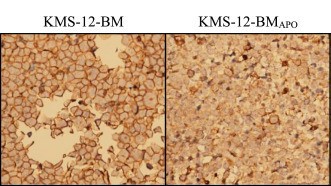Featured Products
Our Promise to You
Guaranteed product quality, expert customer support

KMS-12-BM
- Specification
- Recommended Products
Immunology: CD3 -, CD10 -, CD13 -, CD19 -, CD34 -, CD37 +, CD38 +, cyCD79a +, CD80 -, CD138 +, HLA-DR -, sm/cyIgG -, sm/cyIgM -, sm/cykappa -, sm/cylambda -
Viruses: PCR: EBV -, HBV -, HCV -, HI
- Background
- Scientific Data
- Q & A
- Customer Review
- Product Information Sheet
KMS-12-BM cells are a well-known and extensively studied cell line that was derived from the bone marrow of a 64-year-old woman diagnosed with multiple myeloma in 1988. These cells are considered the sister cell line of KMS-12-PE.
KMS-12-BM cells have been extensively characterized for their phenotypic and genotypic features. They exhibit characteristics typical of multiple myeloma, including abnormal proliferation, dysregulated signaling pathways, and the expression of markers associated with plasma cells.
Researchers have utilized KMS-12-BM cells to study various aspects of multiple myeloma, including disease progression, drug sensitivity, and mechanisms of treatment resistance. These cells have been instrumental in identifying potential therapeutic targets and evaluating the efficacy of novel treatment strategies.
Creation of a Resistant KMS-12-BM Subline
Proteasome inhibitors bortezomib (Btz), carfilzomib (Cfz), and ixazomib (Ixz) are the backbones of the treatment of multiple myeloma (MM). To develop a Btz-resistant cell line using clinically relevant pulse treatment, KMS-12-BM cells were treated twice weekly with 1 h pulses of Btz. As resistance developed, the dose stepwise was increased from 900 nM to 7.2 µM Btz (Fig. 1a) over 6 months, until a sub-line was approximately tenfold more resistant to a 1 h-pulse (Fig. 1b) and continuous Btz treatment. It is named KMS-12-BM-BPR, where BPR stands for "bortezomib-pulse resistant". For brevity, it also refers to BPR. This sub-line did not require culturing in the presence of Btz to maintain resistance and grew at the same rate as the parental line.
There were no specific mutations in the resistant cells (Fig. 1c) and no significant changes in the activities of any of the proteasome's three catalytic subunits (Fig. 1d). 1 h pulse treatment with Btz caused similar inhibition of β5 (i.e., the combined activity of β5c and β5i) and β1 (i.e., combined activity of β1c and β1i) activities in the parental cells and the resistant subclone (Fig. 1e). Thus, resistance in the BPR sub-line is not due to decreased affinity of Btz to the active sites.
 Fig. 1 Development and characterization of Btz-resistant KMS-12-BM-BPR cells. (Downey-Kopyscinski SL, et al., 2022)
Fig. 1 Development and characterization of Btz-resistant KMS-12-BM-BPR cells. (Downey-Kopyscinski SL, et al., 2022)
Characterization of Resistance to APO010 in KMS-12-BM Cell Lines
APO010 is a hexameric Fas-ligand that mimics cytotoxic T-lymphocyte signaling through the Fas-receptor to induce apoptosis. APO010-resistant variants of human multiple myeloma cell lines (KMS-12-BM) were developed. Stable APO010-resistant cancer cell lines were established by exposing the cells to gradually increasing concentrations of APO010 over 6-12 months (Fig. 2). Half-maximal inhibitory concentrations (IC50) for APO010 in each parental cell line were chosen as the starting concentrations of APO010 exposure (Table 1). Cell lines were maintained at each APO010 concentration until there was no further effect of APO010, and then drug concentration was doubled at this point. The developed resistant cell lines were designated as KMS-12-BMAPO.
Development of resistance to APO010 had no significant effect on the proliferation rate of resistant cell lines in comparison to their controls. The KMS-12-BMAPO (33.7 h) cell line had a DT almost the same as the DT of its parental control (34.2 hours). To evaluate the role of Fas in acquiring resistance to APO010, Western blotting of Fas protein expression was performed. A complete downregulation of Fas expression was observed in the KMS-12-BMAPO cell lines (Fig. 3). Reduction in the membrane levels of Fas was observed between the APO010-resistant cell lines and their parental controls by ICC staining. Almost no membrane staining of Fas was seen in the KMS-12-BMAPO cell lines compared with their parental controls (Fig. 4).
 Fig. 2 MTT assay revealing reduced APO010 sensitivity in KMS-12-BMAPO cell lines compared with their parental controls. (Jandu H, et al., 2020)
Fig. 2 MTT assay revealing reduced APO010 sensitivity in KMS-12-BMAPO cell lines compared with their parental controls. (Jandu H, et al., 2020)
Table 1. Initial and final concentrations of APO010 exposure during the development of resistance to APO010. (Jandu H, et al., 2020)
| Cell line | Initial APO010 concentration (ng/L) | Final APO010 concentration (ng/L) | AOP010 IC50 (µg/L) | Relative resistance (RR) | |
| Resistant cell lines | Parental control | ||||
| KMS-12-BMAPO | 5,000 | 100,000 | 1,038±2.1 | 1.9±0.7 | 520.1 |
 Fig. 3 Fas protein expression in APO010-resistant cell lines. (Jandu H, et al., 2020)
Fig. 3 Fas protein expression in APO010-resistant cell lines. (Jandu H, et al., 2020)
 Fig. 4 Immunocytochemistry staining of Fas expression in APO010-resistant cell lines. (Jandu H, et al., 2020)
Fig. 4 Immunocytochemistry staining of Fas expression in APO010-resistant cell lines. (Jandu H, et al., 2020)
The ability to isolate single cells empowers numerous applications. These include cell-line development, monoclonal antibody production, single-cell multi-omics, and the characterization of rare cell types such as circulating tumor cells.
KMS-12-BM cells are considered the sister cell line of KMS-12-PE. Both cell lines were derived from the same patient with multiple myeloma, but each line represents a distinct sublineage of cells with unique characteristics.
KMS-12-BM cells serve as an important research tool for studying multiple myeloma. They are used to investigate disease progression, drug sensitivity, and treatment resistance mechanisms. These cells contribute to identifying potential therapeutic targets and evaluating the effectiveness of novel treatment strategies.
KMS-12-BM cells have been employed in various experimental assays, such as drug screening, gene expression profiling, and functional studies. They are used to investigate molecular mechanisms, identify biomarkers, and understand the underlying biology of multiple myeloma.
Average Rating: 4.7 | 3 Scientist has reviewed this product
Wide-range of applications
The products have a wide range of downstream applications, such as drug screening or gene expression analysis.
21 May 2022
Ease of use
After sales services
Value for money
Prompt delivery
The ordering process was smooth, and the cells were delivered promptly. The quality of the cells has been excellent, allowing for reliable and reproducible experiments.
09 Jan 2024
Ease of use
After sales services
Value for money
Helpful resources
The company's resources, such as the provided protocols and data sheets, have helped optimize my experimental setup.
12 Feb 2024
Ease of use
After sales services
Value for money
Customer Support & Price Inquiry

